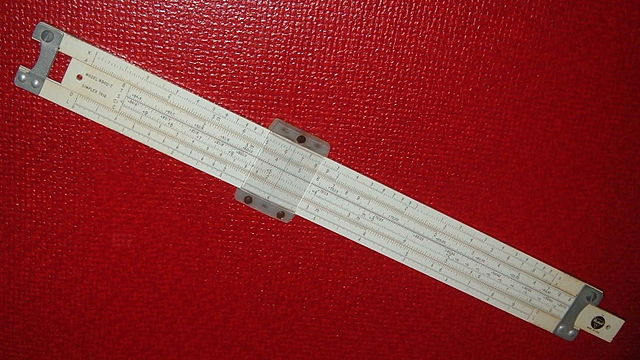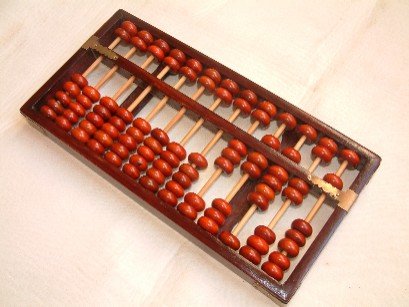Back
Lectures
General designs
Analog systems. Reading : Analog computer
Very fast.
Sorting spaghetti. O of n
Data range infinite.
Precision may be limited.
Continuous calculations.
Coin sorting machine.
Can often work with actual 'object'.
Lower power consumption.
Limited flexibility - system designed for specific tasks.
Radios - convert radio signals to sound but not TV signals.
Slide rules.
 Source : https://en.wikipedia.org/wiki/Slide_rule#/media/File:Sliderule.PickettN902T.agr.jpg
Discrete Digital systems.
Currently binary systems predominate.
Approaching molecular sized units (smallest).
Data converted to sampled representation.
High precision and accuracy if enough resources provided.
Limited finite range of data representation.
Can be designed to be very modifiable.
Most media players (Real, Windows, I-tunes, VLC )
play audio and video in a variety of formats and protocols.
It is possible to have non-binary discrete digital system.
Mechanical digital calculator
Source : https://en.wikipedia.org/wiki/Slide_rule#/media/File:Sliderule.PickettN902T.agr.jpg
Discrete Digital systems.
Currently binary systems predominate.
Approaching molecular sized units (smallest).
Data converted to sampled representation.
High precision and accuracy if enough resources provided.
Limited finite range of data representation.
Can be designed to be very modifiable.
Most media players (Real, Windows, I-tunes, VLC )
play audio and video in a variety of formats and protocols.
It is possible to have non-binary discrete digital system.
Mechanical digital calculator
 Source
Mechanical
Discrete
Decimal (0-9), fixed decimal point.
Abacus
Source
Mechanical
Discrete
Decimal (0-9), fixed decimal point.
Abacus
 Source
More of an accumulator. The user is the calculator (CPU)
Lower row records 0-5
The upper row works as a carry ledger.
One bead is lower + 5
Two beads is lower + 10
1st pass, value entered.
2nd pass, 2nd value added and any carries noted in upper row.
3rd pass, carry carried and cleared.
World is mostly analog
So significant portion of computing is directed to converting between
real analog data and binary representation.
Source
More of an accumulator. The user is the calculator (CPU)
Lower row records 0-5
The upper row works as a carry ledger.
One bead is lower + 5
Two beads is lower + 10
1st pass, value entered.
2nd pass, 2nd value added and any carries noted in upper row.
3rd pass, carry carried and cleared.
World is mostly analog
So significant portion of computing is directed to converting between
real analog data and binary representation.
 Source : https://en.wikipedia.org/wiki/Slide_rule#/media/File:Sliderule.PickettN902T.agr.jpg
Discrete Digital systems.
Currently binary systems predominate.
Approaching molecular sized units (smallest).
Data converted to sampled representation.
High precision and accuracy if enough resources provided.
Limited finite range of data representation.
Can be designed to be very modifiable.
Most media players (Real, Windows, I-tunes, VLC )
play audio and video in a variety of formats and protocols.
It is possible to have non-binary discrete digital system.
Mechanical digital calculator
Source : https://en.wikipedia.org/wiki/Slide_rule#/media/File:Sliderule.PickettN902T.agr.jpg
Discrete Digital systems.
Currently binary systems predominate.
Approaching molecular sized units (smallest).
Data converted to sampled representation.
High precision and accuracy if enough resources provided.
Limited finite range of data representation.
Can be designed to be very modifiable.
Most media players (Real, Windows, I-tunes, VLC )
play audio and video in a variety of formats and protocols.
It is possible to have non-binary discrete digital system.
Mechanical digital calculator
 Source
Mechanical
Discrete
Decimal (0-9), fixed decimal point.
Abacus
Source
Mechanical
Discrete
Decimal (0-9), fixed decimal point.
Abacus
 Source
More of an accumulator. The user is the calculator (CPU)
Lower row records 0-5
The upper row works as a carry ledger.
One bead is lower + 5
Two beads is lower + 10
1st pass, value entered.
2nd pass, 2nd value added and any carries noted in upper row.
3rd pass, carry carried and cleared.
World is mostly analog
So significant portion of computing is directed to converting between
real analog data and binary representation.
Source
More of an accumulator. The user is the calculator (CPU)
Lower row records 0-5
The upper row works as a carry ledger.
One bead is lower + 5
Two beads is lower + 10
1st pass, value entered.
2nd pass, 2nd value added and any carries noted in upper row.
3rd pass, carry carried and cleared.
World is mostly analog
So significant portion of computing is directed to converting between
real analog data and binary representation.